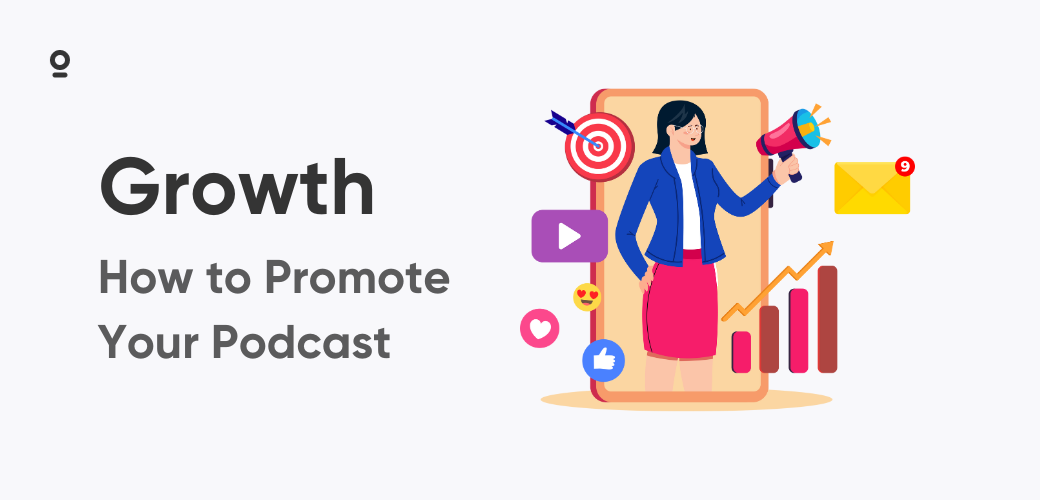You record weekly. Edit carefully. Your guests bring insights, your solo episodes hit hard truths. Downloads stay flat.
Why isn't my podcast visible? Same reason most shows never break through. Good content isn't promotion. 464 million people listen to podcasts in 2025, but discovery happens through deliberate moves, not accident.
This guide will show you how to promote a podcast that actually grows your audience.
Your Website is Mission Control
Your site is mission control for every episode. It's the one platform you own, the central hub where your audience, content, and brand converge. Every other promotional channel should ultimately point back here. For this to work, each episode needs its own dedicated page. No exceptions. This page must feature an embedded player, comprehensive show notes, and a full transcript.
That last part is the secret weapon. Search engines cannot process audio files, but they devour text. Publishing a transcript turns your spoken words into a dense, keyword-rich article that Google can index, radically expanding your show's digital footprint and making you discoverable to listeners actively searching for your topics.
Transcripts and Show Notes are SEO Gold
The role of transcripts in podcasting has fundamentally shifted. Once a courtesy, they are now a core pillar of podcast marketing. This isn't just about raw SEO power. It's about engagement. When a listener can see the entire conversation laid out, they can easily find and share specific quotes, deepening their connection to your content. Interactive transcripts, where clicking a sentence jumps to that audio moment, can dramatically boost listener retention and time on page, both powerful signals to search algorithms.
Your show notes act as the bridge. They should be structured like a high-value blog post, summarizing key takeaways, listing guest bios and links, and providing timestamps for easy navigation. This respect for the listener's time is a promotional tool in itself.
This content lives on your site, but your RSS feed is the engine that distributes it. Get these details right:
- Podcast Title: Keep it concise and keyword-rich, 5-8 words maximum.
- Show Description: Write a compelling summary that naturally incorporates relevant keywords.
- Episode Titles: Make them informative and benefit-focused. "How to Triple Your Sales" beats "Episode 12" every time.
- Categories: Choose the most relevant primary category and use subcategories to hone in on your niche.
- Cover Art: Create eye-catching artwork that's readable even as a tiny thumbnail (1400x1400 to 3000x3000 pixels).
How to Promote Your Podcast Through Your Network
Word-of-mouth has always been a massive driver of discovery, but social media is getting stronger by the day as an engine for growth. Regardless of the channel, your current listeners are your most potent marketing force, but they need direction. A vague "please share" is useless. Instead, give them a specific mission. "If you know one person who needs to hear this advice on negotiating a raise, send them this episode right now." Specificity creates action.
Your email list is the other half of this strategy. It is your direct, unfiltered line to your most loyal fans. Offer a genuinely valuable incentive for signing up, like an exclusive Q&A episode, a detailed resource guide from the episode, or early access to new content. This transforms passive listeners into an engaged community you can mobilize.
Repurpose Your Content Relentlessly
The work isn't over when you publish an episode. For top-tier podcasters, that's when the real marketing begins. You must atomize your content, treating every episode as the raw material for a dozen smaller promotional assets. Understanding this is a cornerstone of learning how to promote a podcast in a crowded digital landscape.
Think about it: one 45-minute episode can become a full content matrix. That means one long-form YouTube video, but also five or six short, captioned video clips for Instagram Reels, TikTok, and YouTube Shorts. It means three or four powerful quote graphics for X and Instagram stories. It means pulling out one key concept and expanding it into a thoughtful LinkedIn post. This approach doesn't just recycle content; it translates your core message for the unique culture and format of each platform, multiplying your points of entry for new listeners.
Nail the Technicals: Professional Sound Matters
Listeners are ruthless. Poor audio quality is one of the top reasons they abandon a show in the first five minutes. It signals amateurism and creates listener fatigue. Professional, consistent sound is a baseline requirement for growth.
Always record each speaker on a separate track locally. Tools like Zencastr make this simple and eliminate the risk of internet glitches ruining an interview. Aim for a consistent loudness level around -16 LUFS. This industry standard ensures your listeners aren't constantly reaching for the volume knob as they listen to different shows. It's about creating a predictable, seamless experience. This isn't just about sounding good; it's about building trust.
How to Publicize a Podcast on Social Media
Don't try to be everywhere at once. Choose one or two platforms where your target audience actively congregates and go deep.
Create a steady stream of assets designed for the platform.
- Audiograms: 30-60 second animated waveform videos with captions.
- Video clips: Short, high-impact moments from your show. Since a huge percentage of social video is watched without sound, captions are non-negotiable for engagement.
- Quote graphics: Visually striking images featuring your most powerful lines.
Automated tools like Zencastr's ZenAI can identify engaging clips and create these assets for you, but the strategy behind them is human. The goal is to provide value and spark curiosity, not just to announce a new episode.
Podcast Marketing Through Collaboration
The fastest way to grow your podcast audience is to get in front of someone else's. Guesting on other podcasts in your niche is the most direct way to do this. Personalize every pitch. Reference specific episodes you enjoyed, explain the unique value you can offer their listeners, and suggest two or three concrete topics.
When you have guests on your show, make promotion frictionless for them. Send every guest a comprehensive promo kit: a direct episode link, pre-written social media posts they can adapt, branded graphics with their headshot, and a folder of short audio or video clips. Busy people are far more likely to share when you've done 90% of the work for them.
Grow Podcast Audience by Measuring Success
You cannot improve what you do not measure. Track these key metrics to understand what's actually moving the needle:
- Download numbers and growth trends
- Subscriber count increases
- Website traffic and referral sources
- Social media engagement rates
- Email open and click-through rates
Use your hosting platform's analytics alongside Google Analytics. When you see a download spike, investigate. Was it the day your newsletter went out? The day you guested on another show? Identify the cause, and then do more of that. Avoid the classic mistakes: publishing inconsistently, neglecting SEO in your titles, and using social media as a megaphone instead of a telephone.
Mastering these elements is fundamental to knowing how to promote a podcast successfully, allowing you to go from shouting into the void to building a real, engaged audience. Test, measure, and double down on what works for your show.
Ready to not only create an amazing podcast but also get it discovered? Zencastr offers the tools to record, produce, and create promotional assets with ease. Start your Zencastr journey for FREE today!







